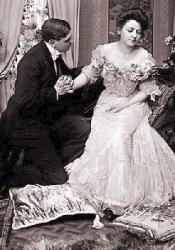Marriage Laws in England
The laws in England were based on the idea that women would get married and that their husbands would take care of them. This is due to the women only being seen as housewives and mothers to their children. Women had no rights, and it was not seen as appropriate for a woman to work outside their household. Extremely poor women had to base almost their entire life on marrying a man who would give them an estate to live on as well as who had a huge inheritance that they could survive on. Until 1823, " a woman had to be at leats 21 years old to be married but this changed to allow women as young as 12-14 to be married" (Vatuna).
Britain passed the 1882 Married Property Act, which states that a woman got married her wealth passed to her husband. Even if a woman worked after she was married, her earnings still went to her husband. “This allowed the idea that upper- and middle-class women had to stay dependent on a man; first as a daughter and later as a wife” (John Simkin). Divorce by the woman was not an option during this time. Although, men during this time with the Matrimonial Causes Act of 1857 gave them the right to divorce their wives on the grounds of adultery. Once divorced, the children can be taken away from the wife and then were property of the father. These marrying ideals is also not mentioning the ration of available men to available women. There was a shortage of available men due to “the mortality rate for boys was far higher than girls, men served in armed forces, and men were more likely to emigrate than women” (John Simkin). In the 1800s, women were clearly used as property instead of treated like humans. They were given no opportunity to make a life for themselves and had to entirely depend on inheritance and bachelor men.
This is impacted the reading of the novel becuase the entire novel is centered around Marianne and Elinor trying to find a man to marry to support themselves and their mother. Their sensibility in the events that take place in the novel make sense due to their entire future resting on finding a man that will choose them. This also adds to the plot of the novel by using Elinor and Marianne to represent the other women in their position during this Victorian time period.
John Simkin. “Marriage in the 19th Century.” Spartacus Educational, Spartacus Educational, https://spartacus-educational.com/Wmarriage.htm.
Vatuna, Molly. “Marriage in the Victorian Era.” COVE, 5 Oct. 2020, https://editions.covecollective.org/chronologies/marriage-victorian-era.

